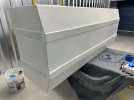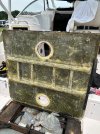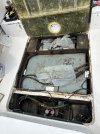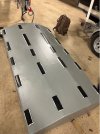I tried using a winch on the front tied to the hardtop, and a cherry picker on the back, but the tank fought me something fierce to stay in its coffin. I finally said enough of this, and took a air chisel to the tank after removing one end of it. It was far easier to remove then, although I did have to take a router to the sides of the opening in the hatch. Once out of the boat, I was astonished to have to look hard for holes. I finally spotted two small 1mm pinholes that were soft although I did not press a probe all the way through them. They had to be a significant source of leak because I filled that tank with water to reduce the chance of a spark and the next day the tank was empty. As expected, the leak was where the rubber strips had trapped moisture against the bottom.
I am about to order a new tank, but I was thinking that the same thing is likely to happen again. If I glue rubber to the bottom of that new tank, then moisture is going to be working away there eventually. Has anyone ever considered welding a few rectangular aluminum pads to the bottom of the tank and then fastening rubber to those pads? The idea is that the rectangular pads would be sacrificial aluminum once the rot starts, which might extend the life of the tank many years. Thoughts?
I am about to order a new tank, but I was thinking that the same thing is likely to happen again. If I glue rubber to the bottom of that new tank, then moisture is going to be working away there eventually. Has anyone ever considered welding a few rectangular aluminum pads to the bottom of the tank and then fastening rubber to those pads? The idea is that the rectangular pads would be sacrificial aluminum once the rot starts, which might extend the life of the tank many years. Thoughts?





